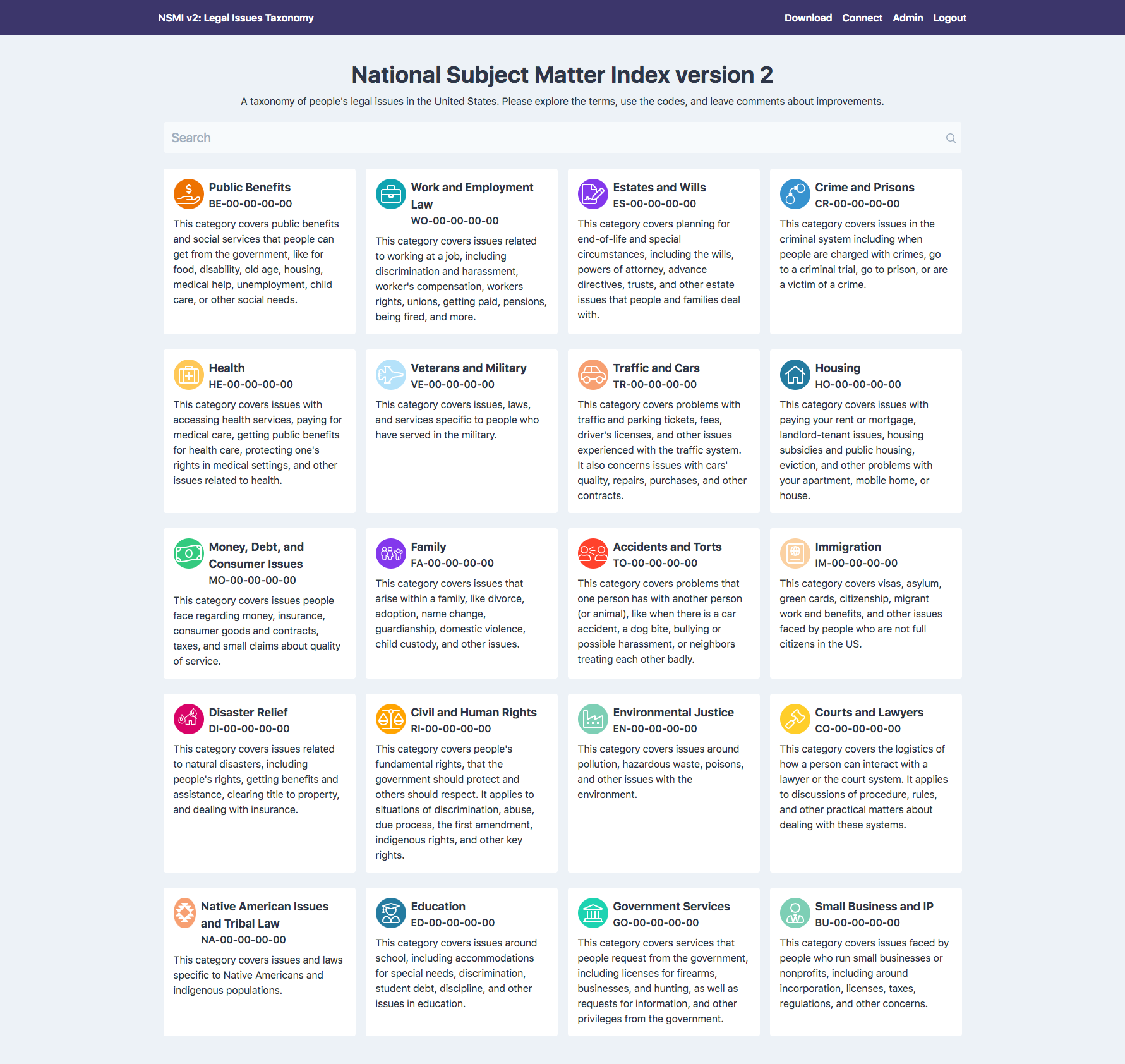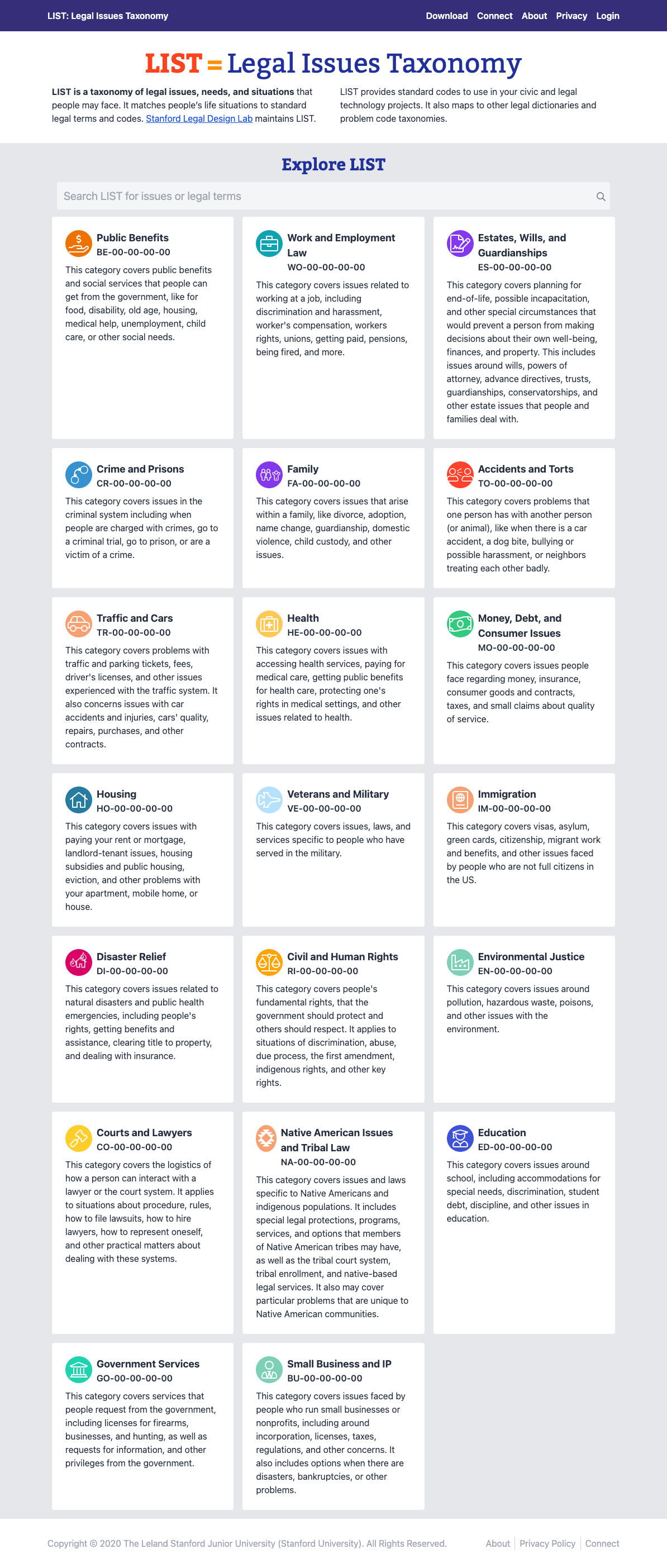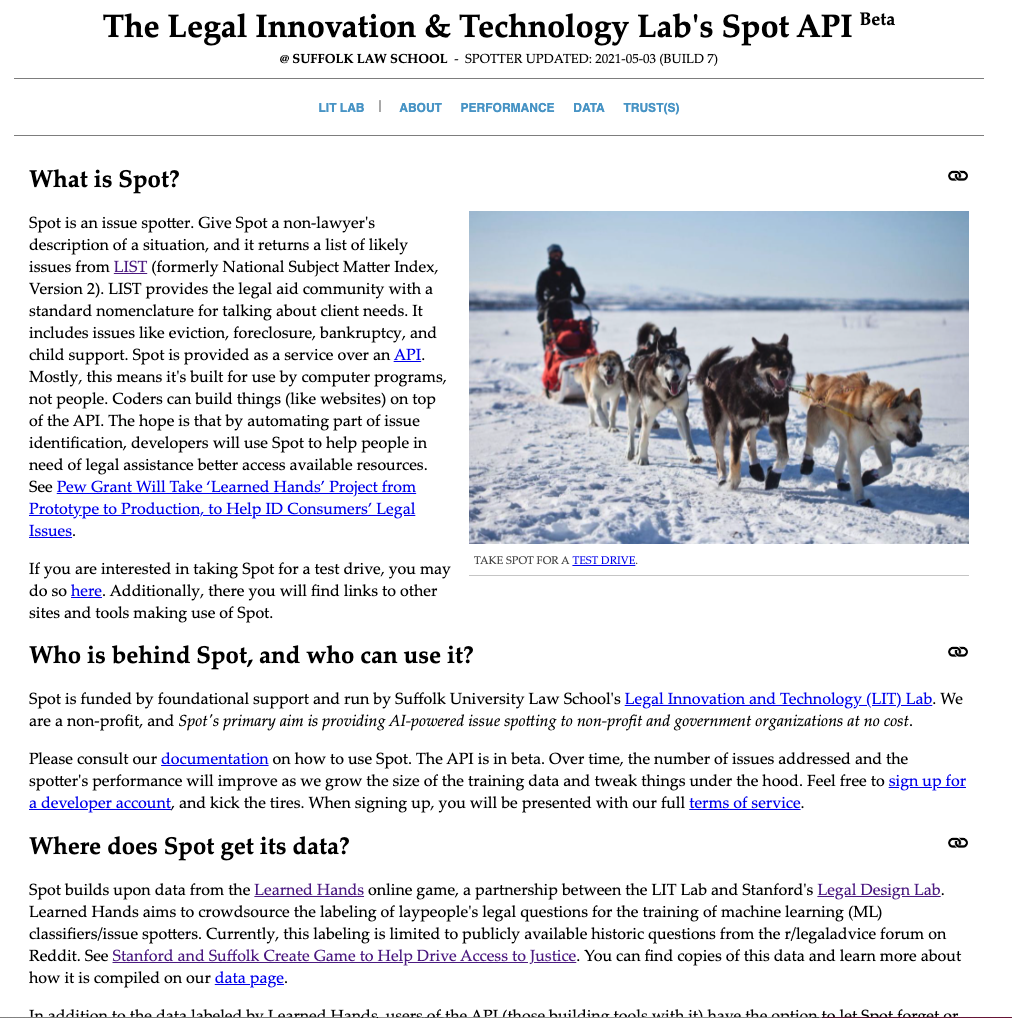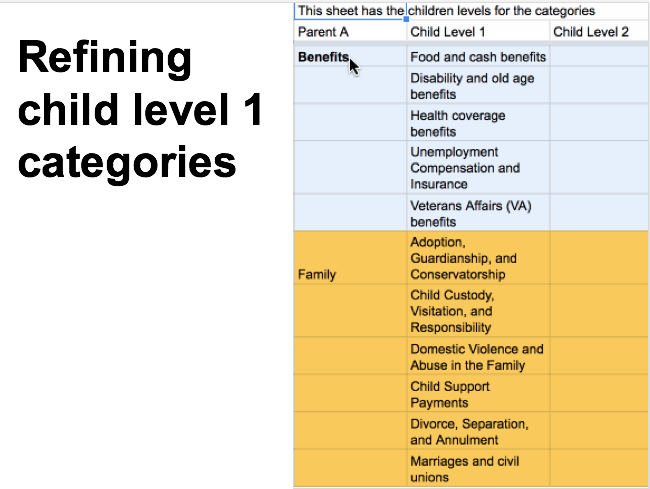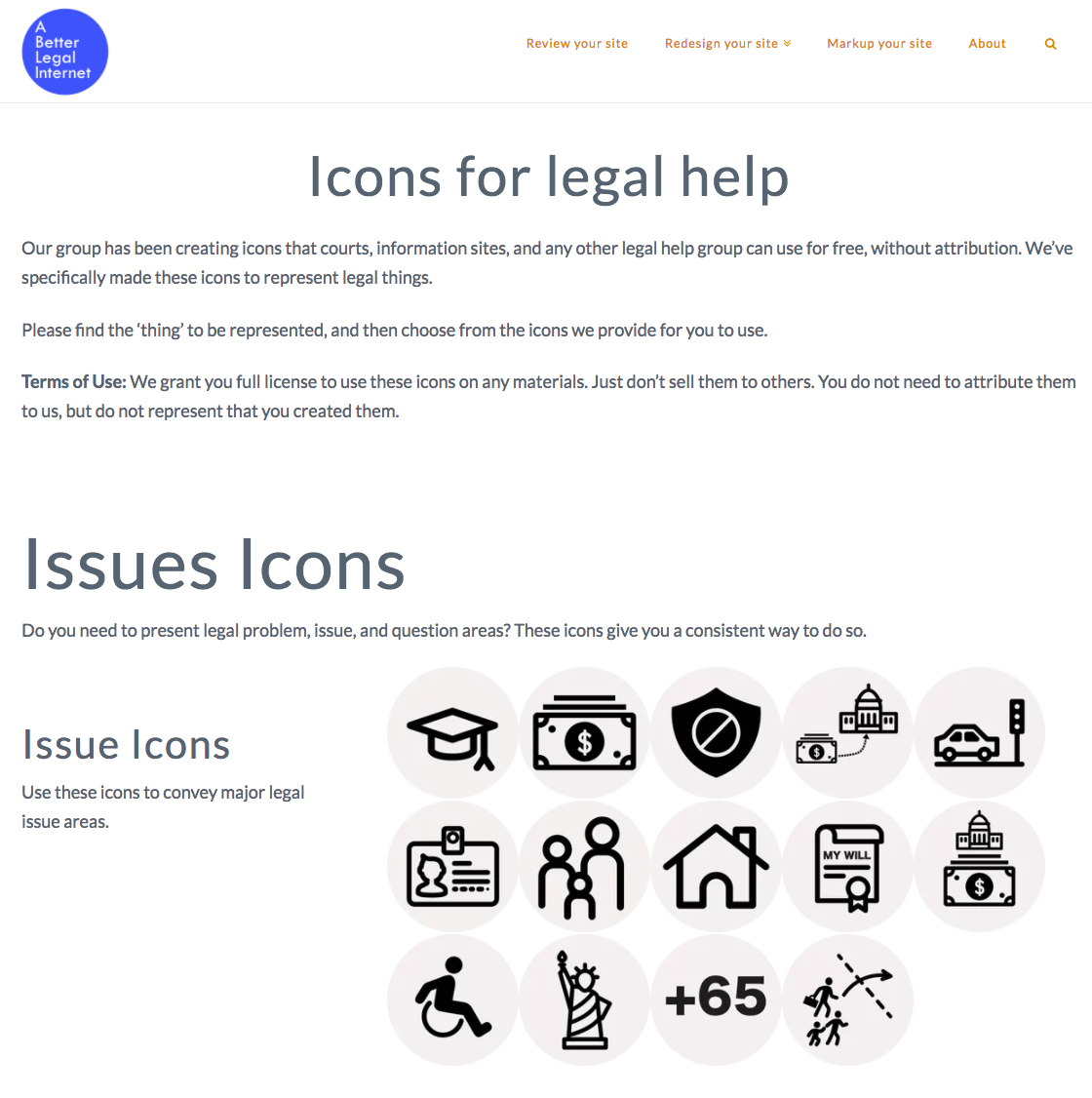1. We need standard codes for legal problems.
There’s lots of different words we can use to describe the same legal problem. Is this thing an unlawful detainer, an eviction action, a landlord-tenant dispute, or getting kicked out of your house? These words come from legal jargon, different jurisdictions’ terminology, and people’s everyday language around the law.
This is a problem for building good legal help online.
To actually, efficiently connect people to help that fits their problem, we need standardized ways of referring to what these problems are. Taxonomy codes are one way to do this. If we have a standard, encoded term from a central taxonomy for each legal problem — then we can use this term to be standardized across websites, apps, and jurisdictions. Even if we use different words (eviction, u.d., kicked out) to call these problems, if we’re always using the same term (HO-02-00-00-00) when we talk about this problem online.
Our lab has spent several years, and with the support of the Pew Charitable Trusts and the Legal Services Corporation, to build this standard taxonomy of legal problem codes. It’s called LIST, the Legal Issues Taxonomy.
So how do you actually use these taxonomy codes?
How do you make these codes work for you and your users?
2. Web administrators can tag their help resources with the LIST codes.
If you run a website that offers legal help — like a legal aid site, a law library, a court help center, or otherwise — you can use these LIST codes to make it easier for people to find your help resources. And you can make it easier for other help providers to link to your resources.
The best way to use the LIST taxonomy codes is to put them in Schema.org markup, that describe your websites’ topics to search engines. You can do that by using this Schema markup creator tool that our Lab has created.
You can make this Schema markup, and then paste it into your website’s header. This markup will describe your legal help organization and the issue areas that you cover. The form automatically puts the right LIST code in for the issue area you select on the page.
Or, you can manually create your own Schema markup using LIST codes. You can use the Schema term KnowsAbout, and then populate it with the LIST codes that represent the legal problems your organization can help people with.
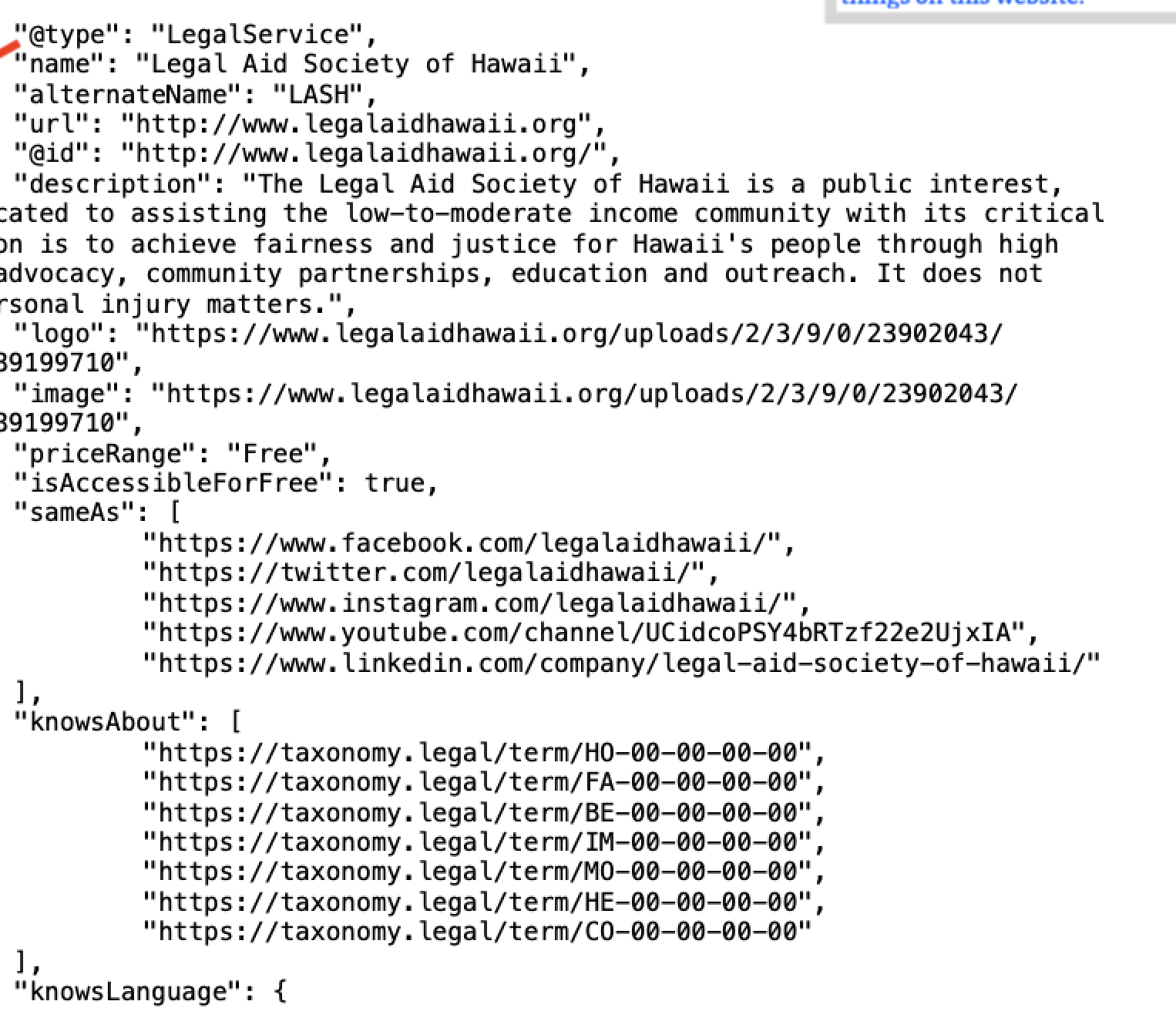
3. App & bot developers can use LIST codes to encode people’s inputs and their responses.
If you build bots, conversational agents, and other apps that go back-and-forth with users, then the LIST taxonomy codes can help you tag what people are asking for help with. And you can similarly encode the resources and links you’re offering to your users.
For example, our Lab’s Eviction Help Bot can spot people’s legal problems around possible evictions and landlord-tenant. It does this by running people’s posts on the Reddit/LegalAdvice forum through the SPOT tool from Suffolk LIT Lab.
We have SPOT read the post and then determine if one of the LIST legal problem codes seems to be present. If a LIST problem code around eviction probably applies, then the Eviction Help Bot replies to that Reddit-user with an automatic message about websites that could help them.

When we were building that bot, we programmed which LIST problem codes the bot should be sensitive to. Other bot- or agent-developers can use the LIST codes similarly.
- Set up SPOT account and connection. You can set up an account and a way for your tool to make calls to SPOT through its API,
- Use SPOT to make sense of your users’ text: You pass a piece of user-generated text (a search query, a paragraph description of a problem, a transcription of an intake call) over for SPOT to categorize, and then
- Get the LIST problem codes back from SPOT: You have SPOT return the LIST issue codes that seem to be present.
- Have your tool use the codes to reply intelligently: You have your bot or agent respond accordingly. You have automated responses or links associated with certain LIST issue codes. If eviction issue codes are returned, then have the bot reply with links to eviction help resources. If divorce issue codes are returned, then you can have an automatic message on the divorce process.
4. Referral link to other groups’ webpages & contacts based on their LIST-encoded expertise
This last use case is a more ambitious one. It requires multiple legal help groups to coordinate using the LIST problem codes.
Let’s say that you run a lawyer referral system, and want to better match people calling in to a lawyer that can help them with a specific problem.
Or let’s say that you run a legal help website, and want to be able to direct visitors to the right online resources for the problem they have. Maybe your group’s website has self-help materials on debt, wage theft, and repossession. But you don’t have many materials on protective orders, divorce, custody, or other family law matters.
And maybe you serve clients in southern Ohio, but not in central or northern Ohio (or from other states or countries). You don’t want to be giving incorrect legal procedure guidance to visitors. You want to make sure they find local-jurisdiction help.
LIST codes could help you make better hand-offs for your web visitors or people calling into your referral line. If you have used LIST to encode legal help websites’ expertise topics, or lawyers’ expertise areas, then you can easily find the right next step for the person.
If other legal help groups are using LIST codes to describe the issues they have resources on, and the jurisdictions they serve — then you could use this information to tell your visitor which website they should be visiting to get issue- and jurisdiction-correct help.
This would require making a referral database system using the LIST codes and jurisdiction codes, and then having a search/input function on your website. When your visitor searches for a certain issue/location, or inputs a story about an issue/location, then your site can draw from the referral database to pass the visitor off to the best website for them.
We haven’t yet built this kind of intelligent referral system — but we know others are starting to. This can include through steps like:
- Having lawyers or legal groups all report what issue areas they can help with, or that they have self-help resources on. Ideally, this would be on a structured form, with a drop-down or multiple choice list of issue area options. These submissions should all be encoded with standard LIST problem codes. Then this will make it easier to search for and identify which lawyers/websites could be good matches for a specific person.
- Creating a master-list of legal help websites, and which URL pages have help for certain issue areas. This entails collecting a database/spreadsheet of main website pages, as well as specific sub-pages that have help for certain problem areas. Each page’s listing should have fields that describe the LIST problem codes present on the page, and the jurisdiction code for what it applies to. Then people and tech tools can draw from this master-list to find the local, issue-specific page to refer people to. You can see the start of such a master-list here.
